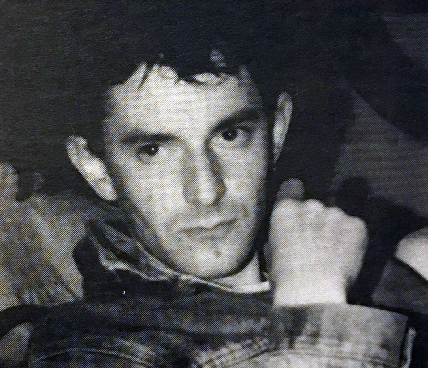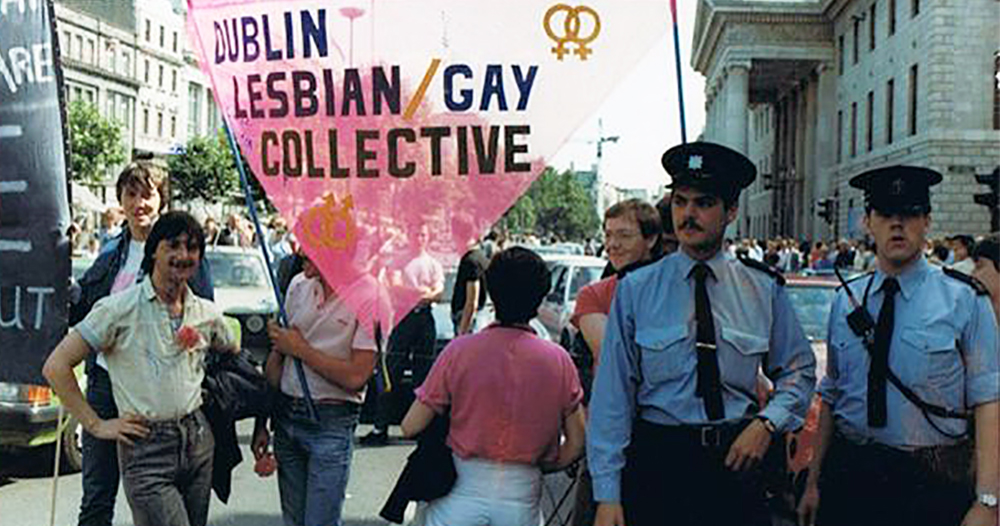On 29 June 2019, Dublin’s LGBT+ community will take to the streets in their tens of thousands to celebrate Pride. Many more will participate in the myriad of events organised throughout the city over the ten days of the LGBT+ Pride festival. Such is the popularity of Pride today that many of these events will receive considerable corporate sponsorship and buy-in from the majority of the political class, many of whom, in fact, will be seen marching in the LGBT+ Pride parade. Moreover, for the first time ever in 2019 uniformed Gardaí will also march in the Pride Parade.
The theme for this year’s Dublin Pride is ‘Rainbow Revolution’, which aims to celebrate and pay tribute to the 50th anniversary of the Stonewall Riots, which were credited with sparking the rise of gay liberation movements throughout the world in 1969. This year’s Pride celebration will, however, have an extra dimension to it as it also marks the 40th anniversary of the first Pride Week held in Ireland from June 25 to July 1 1979. Mary Rice, writing in the Irish Times at the time, noted that “Dublin citizens will find a number of their fellow-citizens sporting triangles. If in their curiosity they ask the meaning of this symbol, they will be told that it celebrates “Pride Week”, that is, that it asserts an acceptance of and even pride in being homosexual.”
Ireland’s first Pride Week was organised by the National Gay Federation at the newly opened Hirschfeld Centre in Temple Bar. The National Gay Federation, which was only founded in March 1979, sought to join other members of the International Gay Association in commemorating the 1969 Stonewall Riots. There can be no doubt that the National Gay Federation sought to be part of an international community commemorating this important event, but they also sought to use the occasion to draw attention to the very difficult situation facing Irish homosexuals; to further a public discourse on LGBT+ rights; to confront their oppression and demonstrate pride in their sexuality.
In a sign of the importance attached to LGBT+ law reform and securing support from the political class, the 1979 Pride Week kicked off with a political forum on homosexuality at the Hirschfeld Centre. Those who participated included high-profile politicians such as Michael Keating, Fine Gael, Ruairi Quinn, Labour Party, Niall Andrews, Fianna Fail and former Minister for Health Dr Noel Browne. Two years earlier Niall Andrew’s party colleague and former Minister for Justice, Gerard Collins, in response to a question by Noel Browne on whether or not he would amend the laws which criminalised sexual activity between males, responded, “I am honestly convinced I have other priorities which must be dealt with before I get to this particular one”. With the rare exception of Dr Noel Browne, this was a general sentiment shared by the majority of politicians in Ireland at that time.
While the political forum did not lead to any major shift in political support for LGBT+ rights, it nevertheless demonstrated the National Gay Federation’s media savviness, as the forum attracted the attention of the Irish Times, which reported on it and the wider Pride celebrations taking place that week. That the Irish Times and other media outlets such as In Dublin and Hot Press promoted the 1979 Pride Week was in itself highly significant in the context of strict censorship laws and the legal status of sexual activity between males. The Irish Times even included the different events taking place that week in its ‘What’s on’ section, bringing Pride Week to the wider attention of Irish society.
According to the London based Gay News, one of the highlights of the week was the Hirschfeld Centre open night, which saw members of the public invited into the Hirschfeld Centre to learn about it and the National Gay Federation. This formed part of the National Gay Federation’s strategy of seeking to engage with the wider community on LGBT+ rights. Gay News reported that the organisers were “delighted” with the success of the venture noting that it “cut away a lot of the mystery about what we get up to”. One mother who attended was even reported to have expressed her wish to start a support group for parents of homosexuals.
Other significant events throughout the week included a leafletting campaign at the top of Grafton Street and a public picnic in Merrion Square. The Merrion Square picnic, which in many respects was the forerunner to the first Pride Parade in June 1983, became a staple of Dublin’s early Pride Week celebrations. Writing on the 1980 Gay Pride picnic, Tonie Walsh, of the National Gay Federation, remarked that “if one could only visualise 70 faggots and dykes all bedecked with pink carnations and triangles squatting on the grass in the middle of a public park! The sun shone down in all its glory on beaming happy faces and everyone, I think, enjoyed themselves immensely.”

Not everyone, however, was able to partake in the Pride Week festivities. While the NGF sought to be as visible as possible during Pride Week, there was, nevertheless, a recognition that the majority of Irish homosexuals were not in a position to come out publicly and associate themselves with LGBT+ rights. This was clearly evident in the language used by the National Gay Federation in its notice to members on participating in the International Solidarity Day. On this day LGBT+ organisations throughout the world encouraged their members to wear a pink carnation – the symbol chosen to commemorate the Stonewall Riots.
While the National Gay Federation encouraged as many members as possible to wear the pink carnation, they also recognised the reality of doing so in 1970s Ireland, stating that “if you feel you can afford to, i.e. if you won’t lose your job or your home, wear a pink carnation on this day. If not a carnation, a pink triangle or an LGBT+ Pride badge. If you feel that you cannot afford to come out in this way well then tell a friend, a brother, or sister, father or mother that you are gay. Tell someone you are close to and show your pride.” This reflected the reality that many could, and often did, lose their jobs because of their sexual orientation in the absence of any legal protections.
That some Irish homosexuals were actually willing to publicly wear a pink carnation or Pride badge during this period was all the more remarkable. In fact, some even sought to openly confront their oppression during Pride Week. This was particularly evident with the last event of the week, and possibly the most radical event of the week, the ‘pub zap’. This involved gay and lesbian individuals wearing a pink carnation or Pride badge and going into as many bars as possible in the city and seeing how quickly they could get barred. The National Gay Federation explained that “in a pub, zap gays seem to lose by winning. That is we may force people to think about the gay issue but suffer rejection as a result. In that sense, these annual ‘booze-ups’ are ideally named: ZAP.” One individual who spoke to Gay News about being ejected from Tobin’s bar during the 1979 ‘pub zap’ because he was wearing a Pride badge stated that “it was only to be expected, I suppose. They haven’t seen the last of us yet. It’s about time a touch of gay pride crept into a bar like this.” During the 1982 Gay Pride Week ‘pub zap’ National Gay Federation members were refused service in five out of the eight pubs they visited.
In comparison with today’s Pride festival, the Pride Week celebrations in 1979 might seem mundane, particularly with the absence of a Pride parade. However, in the context of 1970s Ireland when sexual activity between males was a criminal offence and the Roman Catholic Church still wielded considerable sway over Irish society, the very notion of publicly celebrating, as Rice noted, “pride in being homosexual” was radical, brave, and pioneering. In fact, Ireland’s 2019 Pride festivities owe much to the efforts of those who organised and participated in the 1979 Pride Week. It was the 1979 Pride Week that began the process of celebrating Pride in Ireland.
While Dublin’s 2019 Pride will celebrate the 50th anniversary of the Stonewall Riots we should also remember and celebrate significant moments in our own Irish Queer History. The first Pride Week in Ireland in June 1979 is one such significant moment. In doing so we can develop a deeper appreciation of how significant it is that tens of thousands of LGBT+ individuals feel empowered to march down the heart of Dublin city celebrating pride in who they are, a far cry from events in 1979.
© 2019 GCN (Gay Community News). All rights reserved.
Support GCN
GCN is a free, vital resource for Ireland’s LGBTQ+ community since 1988.
GCN is a trading name of National LGBT Federation CLG, a registered charity - Charity Number: 20034580.
GCN relies on the generous support of the community and allies to sustain the crucial work that we do. Producing GCN is costly, and, in an industry which has been hugely impacted by rising costs, we need your support to help sustain and grow this vital resource.
Supporting GCN for as little as €1.99 per month will help us continue our work as Ireland’s free, independent LGBTQ+ media.
